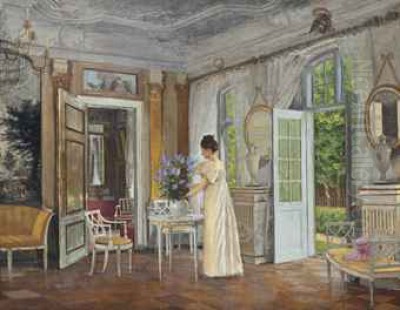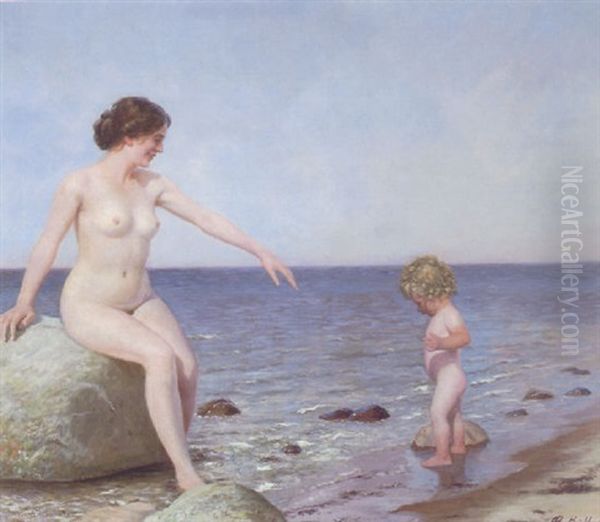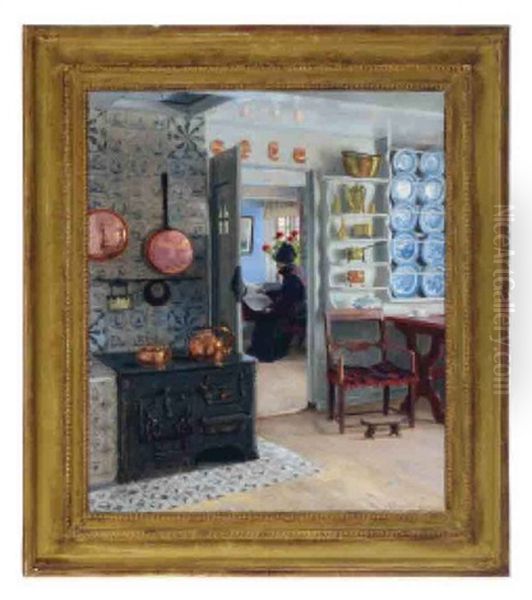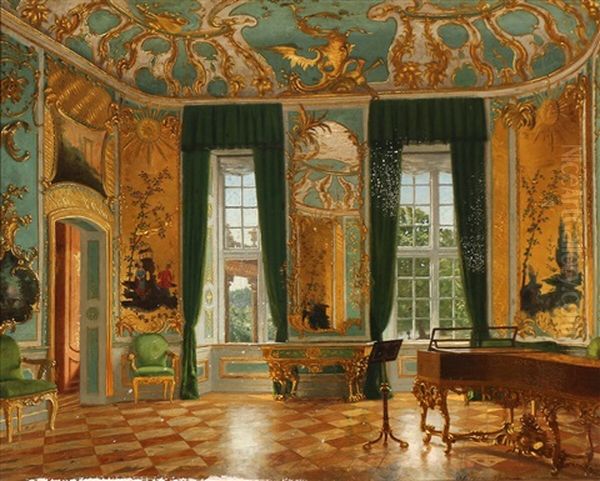
Adolf Heinrich Claus Hansen stands as a figure of quiet dedication within the annals of Danish art. Born in the vibrant cultural hub of Copenhagen in 1859, his life journey took him from the prospects of theology to the dedicated practice of painting, culminating in a reputation for meticulously rendered interior scenes. Though perhaps not as globally renowned as some of his contemporaries, Hansen carved a distinct niche for himself, characterized by technical precision, a keen understanding of architectural space, and a subtle mastery of light and color. His death in Fredensborg, Sweden, in 1925 marked the end of a career devoted to capturing the essence of inhabited spaces with realism and sensitivity.
Understanding Hansen requires appreciating the artistic environment he emerged from. Denmark in the mid-to-late 19th century was still processing the legacy of its Golden Age painters, figures like Christoffer Wilhelm Eckersberg, who had instilled a tradition of careful observation and technical skill. Concurrently, new movements were stirring across Europe, including Realism and the nascent stirrings of Impressionism, challenging academic norms and encouraging artists to depict the world around them with unvarnished honesty. Hansen navigated this evolving landscape, ultimately embracing a form of detailed realism particularly suited to his chosen subject matter.
Early Life and a Change of Path
Born into an environment steeped in aesthetics and structure, Adolf Hansen's early life was significantly influenced by his father, a professor of architectural art and a senior figure in art education. This familial connection to the principles of design, perspective, and spatial representation undoubtedly planted seeds that would later flourish in Hansen's own artistic endeavors. The precision required in architectural drawing, the understanding of form and volume, and the interplay of light within structures likely formed an unconscious foundation for his future work.

Despite this artistic background, Hansen's initial academic pursuit was not art, but theology. He dedicated four years to religious studies, a path suggesting an introspective or scholarly inclination. This period, though seemingly divergent from his eventual career, may have honed his capacity for focused study and contemplation – qualities that are certainly evident in the patient detail of his paintings. The reasons for his eventual shift from theology to art remain personal, but it marked a decisive turn towards the visual world that would define his professional life.
The transition was formalized through dedicated training. Hansen enrolled in C.F. Andersen's School of Drawing, a preparatory step likely intended to build foundational skills. Following this, he gained admission to the prestigious Royal Danish Academy of Fine Arts in Copenhagen, studying there from 1883 to 1886. This period placed him within the heart of Denmark's official art establishment, exposing him to rigorous academic training and the prevailing artistic currents of the time. The Academy, with its long history, was a crucible where tradition met emerging ideas, providing Hansen with the technical grounding essential for his later detailed style.
The Development of a Distinctive Style: Interiors and Light
Upon completing his formal education, Adolf Heinrich Claus Hansen began to cultivate his specific artistic voice. He gravitated towards interior scenes, a genre that allowed him to synthesize his innate understanding of architectural space with a painter's sensitivity to light, color, and atmosphere. His style became characterized by a meticulous, detailed realism. He wasn't merely depicting rooms; he was exploring the character of spaces, often defined by their structure and the way light interacted with them.
A hallmark of his work, as noted by observers, was his exceptional skill in handling perspective and architectural elements. This likely echoes his father's influence and his own rigorous training. His paintings often feature strong linear perspective, drawing the viewer's eye into the space and creating a convincing illusion of depth. Walls, doorways, furniture, and floor patterns are rendered with careful attention to their geometric form and spatial relationships, lending his scenes a sense of order and structural integrity.

Complementing his structural precision was a sophisticated use of color and light. Hansen favored harmonious color palettes, often employing subtle gradations of tone to describe form and atmosphere. Large windows frequently feature in his compositions, serving not just as architectural details but as primary light sources. He excelled at capturing the diffusion of natural light as it streamed into a room, illuminating surfaces, casting soft shadows, and defining the overall mood of the space – whether cool and tranquil or warm and inviting. This focus on light links him to a long tradition of interior painters, including Dutch masters like Johannes Vermeer.
Architectural Acumen in Paint
The influence of architecture on Hansen's work cannot be overstated. It moves beyond mere accurate depiction; it informs the very composition and feeling of his paintings. His father's profession provided more than just subject matter; it likely imparted a way of seeing – an appreciation for the logic of structure, the elegance of lines, and the volumetric reality of space. Hansen translated this understanding onto the canvas.
His interiors often feel solid and believable because the underlying structure is so convincingly rendered. He doesn't shy away from complex perspectives or the accurate portrayal of architectural details like moldings, cornices, or window frames. These elements are not treated as mere background but as integral parts of the composition, contributing to the overall realism and spatial coherence. This contrasts with artists who might use interiors more as a stage for human drama, where the setting itself is secondary. For Hansen, the space often feels like the primary subject.
This architectural sensibility also informs his treatment of light. Understanding how buildings are constructed involves knowing how light enters and interacts with surfaces. Hansen's depictions of light falling across floors, reflecting off polished wood, or silhouetting objects against a window demonstrate an observational acuity likely sharpened by an awareness of architectural principles. The large windows prominent in his work become conduits for this interplay, transforming rooms into studies of light and shadow shaped by structural boundaries. His paintings become quiet celebrations of ordered space and the ephemeral beauty of light within it.
Themes and Atmosphere in Hansen's Interiors
While renowned for his technical skill in depicting architecture and perspective, Hansen's interiors are more than just exercises in draftsmanship. They often convey a distinct atmosphere, typically one of tranquility, order, and quiet domesticity. Although detailed information about specific recurring themes or narratives is scarce, the overall impression from descriptions of his work suggests a focus on peaceful, well-kept bourgeois or perhaps artistic environments.

Figures, when they appear, are often integrated naturally within the setting, seemingly engaged in quiet activities or contemplation. They don't usually dominate the scene but rather inhabit it, becoming part of the overall composition and reinforcing the sense of lived-in space. The specific relationship between figure and environment in his work warrants closer study of extant paintings, but the emphasis appears to remain on the meticulously rendered setting itself.
The "harmonious colors" noted in descriptions contribute significantly to the prevailing mood. Avoiding jarring contrasts, Hansen seems to have preferred palettes that create a sense of calm and unity. Combined with the often-abundant light streaming through windows, his interiors can feel serene, sometimes even bordering on the melancholic stillness found in the works of his slightly younger Danish contemporary, Vilhelm Hammershøi, although Hansen's style is generally described as more straightforwardly realistic and less overtly Symbolist or enigmatic than Hammershøi's.
The Berlin Professorship: A German Interlude?
One intriguing detail mentioned in the source material is that Adolf Heinrich Claus Hansen held a position as a professor at the Berlin Art Academy. This suggests a period spent in Germany, engaging with a different artistic milieu. Berlin, around the turn of the 20th century, was a dynamic art center, witnessing the rise of the Berlin Secession, a movement challenging the conservative establishment and embracing styles like German Impressionism and Symbolism.
If Hansen did indeed teach in Berlin, it places him in proximity to influential figures like Max Liebermann, Lovis Corinth, and Max Slevogt, leading proponents of German Impressionism. It also raises questions about potential cross-cultural influences. Did the Berlin art scene impact his style, or did he remain steadfast in his detailed realism? Did he exhibit with the Secession or maintain ties with the more traditional Academy structures? Further research would be needed to confirm the exact nature and dates of this professorship and its impact on his career.
Assuming the professorship is accurate, it adds another dimension to Hansen's profile, suggesting recognition beyond Denmark's borders. Teaching at a major institution like the Berlin Art Academy would imply a high level of technical mastery and pedagogical ability. It positions him not just as a practitioner but also as an educator, potentially influencing a younger generation of artists in Germany. This German chapter, however brief or undocumented it may currently seem, hints at a broader engagement with European art currents than his Danish roots might initially suggest.
Considering a Representative Work: The "Mother and Child" Question
The provided information identifies "Mother and Child at the Beach" as a representative work by Adolf Heinrich Claus Hansen. However, this attribution is immediately complicated by conflicting information within the same source material, which also attributes a painting of this title and theme to Pablo Picasso (specifically his Blue Period, dated 1902) and, separately, to the British illustrator Kate Greenaway (dated 1898, referencing a work in the Cleveland Museum of Art). This creates significant confusion.
Given Hansen's established reputation as a painter of interiors with strong architectural elements, a beach scene seems somewhat atypical, though not impossible. Artists' oeuvres often contain diverse subjects. However, the multiple, conflicting attributions for this specific title strongly suggest an error or conflation in the source data. It is highly improbable that Hansen, Picasso, and Greenaway all have a famous, representative work identically titled "Mother and Child at the Beach" from roughly the same period. Picasso's works of this theme are well-documented, as are Greenaway's illustrations.
Therefore, while acknowledging the input's mention of this title in connection with Hansen, it is crucial to approach this claim with extreme caution. It seems more likely that Hansen's truly representative works are his numerous detailed interior scenes, which perfectly align with the descriptions of his style: mastery of perspective, architectural accuracy, and sensitive handling of light within domestic spaces. His legacy rests firmly on this genre, rather than on a potentially misattributed beach scene. His contribution lies in the consistent quality and specific focus of his interior paintings.
Hansen in the Context of Danish Art
To fully appreciate Adolf Heinrich Claus Hansen's contribution, it's helpful to place him within the context of Danish art during his active years (roughly the 1880s through the early 1920s). This era followed the Danish Golden Age and saw a diversification of styles. The Skagen Painters, including P.S. Krøyer, Michael Ancher, and Anna Ancher, were gaining fame for their vibrant, light-filled depictions of fishermen and coastal life, often painted en plein air, embracing elements of Realism and Impressionism.
Hansen's meticulous, often indoor-focused realism presents a different facet of the period. While sharing Realism's commitment to depicting the observable world, his approach was generally more controlled and detailed than the looser brushwork often seen in Skagen paintings or French Impressionism. His work resonates more closely with the tradition of precise rendering inherited from Eckersberg, but applied to contemporary domestic interiors.
Perhaps the most relevant contemporary comparison within Danish art is Vilhelm Hammershøi (1864-1916). Both artists specialized in interiors, often depicted with a quiet, contemplative mood. However, Hammershøi's work typically features a more restricted, tonal palette, softer focus, and a more pronounced sense of psychological mystery or emptiness, often aligning him with Symbolism. Hansen's realism appears more direct, his spaces more clearly defined by light and structure, less imbued with overt ambiguity. Other notable Danish contemporaries exploring realism and related styles included Laurits Andersen Ring, known for his socially conscious rural scenes often tinged with symbolism, and Theodor Philipsen, who pioneered Impressionism in Denmark. Hansen's work occupies a space centered on detailed, architecturally sound interior realism.
Broader European Connections and Influences
While rooted in the Danish tradition, Hansen's art also connects to broader European trends. His commitment to realism aligns him with the major art movement that dominated much of the mid-to-late 19th century across the continent. French artists like Gustave Courbet and Jean-François Millet had championed the depiction of everyday life and ordinary people, rejecting idealized academic subjects. Hansen's focus on contemporary interiors participates in this broader realist ethos.
His specific choice of subject matter – the interior – has a long and rich history in European art, most notably in 17th-century Dutch painting. Artists like Johannes Vermeer and Pieter de Hooch masterfully captured domestic spaces, exploring the effects of light and creating scenes of intimate tranquility. While Hansen worked in a different era and style, the fundamental interest in rendering the nuances of light, texture, and spatial arrangement within a room connects him to this lineage. His emphasis on perspective and architectural accuracy might also recall the precision of earlier Northern European traditions.
If the Berlin professorship is factual, his connection to the German art scene is also relevant. German Realism had its own strong proponents, such as Adolph Menzel, known for his detailed historical and contemporary scenes (including interiors), and Wilhelm Leibl, admired for his unvarnished portraits and depictions of peasant life. While direct influence is speculative without more evidence, Hansen's detailed approach would have found parallels within certain strands of German art during his potential time there. His work, therefore, can be seen as a Danish interpretation of themes and stylistic concerns shared across Europe.
Later Life and Artistic Legacy
Details about Adolf Heinrich Claus Hansen's later life remain relatively sparse in easily accessible records. We know he passed away in Fredensborg, Sweden, in 1925. Fredensborg, known for its royal palace, is located just across the Øresund strait from North Zealand, Denmark, suggesting he may have maintained close ties to his homeland even if residing in Sweden towards the end of his life. The reasons for his move or the extent of his artistic activity in these final years require further investigation.
Assessing Hansen's legacy involves acknowledging his specific contribution. He was a highly skilled painter who excelled in a particular genre: the detailed, realistic interior. His strengths lay in his technical proficiency, his command of perspective, his understanding of architectural form, and his sensitive rendering of light. He created convincing, often peaceful depictions of domestic spaces that reflected the tastes and environments of his time.
While he may not have achieved the widespread fame of the Skagen Painters or the critical intrigue of Hammershøi, Hansen represents an important aspect of Danish art in the late 19th and early 20th centuries – the continuation of realist principles applied with technical rigor and a focus on the intimate environment of the interior. His work offers valuable insights into the aesthetics and atmosphere of the period's domestic settings. The potential Berlin connection adds a layer of international engagement that merits further exploration. His paintings stand as testaments to a dedicated career focused on the careful observation and representation of the spaces people inhabit.
Conclusion: A Master of Quiet Spaces
Adolf Heinrich Claus Hansen emerges from the historical record as a dedicated and highly competent artist, a master of the interior scene whose work is characterized by realism, architectural precision, and a nuanced understanding of light. Born into an architecturally minded family and formally trained at the Royal Danish Academy of Fine Arts, he developed a distinctive style focused on capturing the structure and atmosphere of domestic spaces. His paintings, known for their harmonious colors and detailed rendering, offer a window into the quiet environments of his era.
While navigating an art world that included the vibrant plein-air painting of the Skagen group (Krøyer, the Anchers) and the enigmatic interiors of Hammershøi, Hansen maintained his commitment to detailed realism. His potential tenure as a professor in Berlin suggests a reputation that extended beyond Denmark, placing him in the context of broader European art movements, including German Realism (Menzel, Leibl) and the legacy of Dutch interior masters (Vermeer, De Hooch). Though questions remain, particularly regarding the attribution of specific works like "Mother and Child at the Beach," his primary legacy is secure in his skillful and sensitive depictions of architectural interiors. Hansen's art remains a quiet but compelling testament to the beauty found in ordered spaces and the subtle play of light within them.